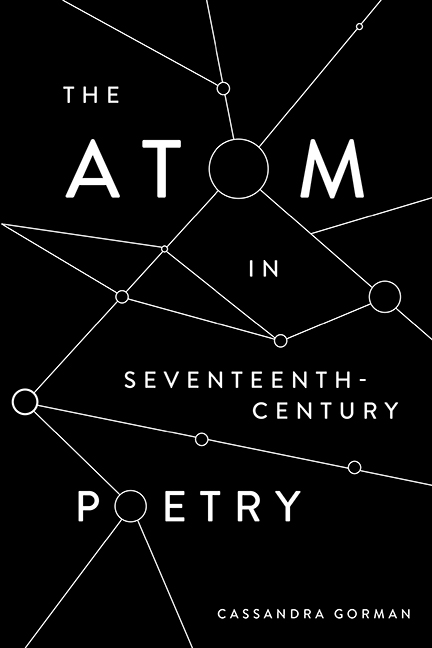Book contents
- Frontmatter
- Dedication
- Contents
- Acknowledgements
- Conventions and Abbreviations
- Introduction
- 1 Atomic Congruity: The Philosophical Poetry of Henry More
- 2 Thomas Traherne’s Atoms, Souls and Poems
- 3 World-Making and World-Breaking: The Atom Poems of Margaret Cavendish and Hester Pulter
- 4 The Atom in Genesis: Lucy Hutchinson’s Order and Disorder
- Afterword: A Poetics of the Atom
- Bibliography
- Index
- Studies in Renaissance Literature
Afterword: A Poetics of the Atom
Published online by Cambridge University Press: 16 July 2022
- Frontmatter
- Dedication
- Contents
- Acknowledgements
- Conventions and Abbreviations
- Introduction
- 1 Atomic Congruity: The Philosophical Poetry of Henry More
- 2 Thomas Traherne’s Atoms, Souls and Poems
- 3 World-Making and World-Breaking: The Atom Poems of Margaret Cavendish and Hester Pulter
- 4 The Atom in Genesis: Lucy Hutchinson’s Order and Disorder
- Afterword: A Poetics of the Atom
- Bibliography
- Index
- Studies in Renaissance Literature
Summary
In his Cold War science fiction novel Riddley Walker, Russell Hoban reimagines the landscape of Kent two thousand years after nuclear war. Hoban writes in an envisioned future dialect: its sounds and spellings gesture at the interactions between a long-forgotten Christianity and terminologies of science and technology, traces of which remain only in the inhabitants’ mythology. The myth that civilisation fell after the death of the ‘Littl Shynin Man the Addom’ who ‘runs in the wud’ conflates the splitting of the atom with the Fall of Adam. What is left in the aftermath is a devastated physical landscape, but it is still ‘humming’ with spiritual significance. The concept of the atom has once again entered the remit of theology, as the protagonist Riddley discovers when he reaches the ruins of Canterbury Cathedral. He sinks to his knees with wonder, overcome with the realisation that the moving ‘party cools of stoan’ inspire ‘the girt dants of the every thing’ that ‘keaps the stilness going’.
Writing in 1980 and projecting his characters thousands of years into a postapocalyptic future, Hoban centres on a mystical connection between ‘Adam’ and ‘the atom’ very similar to the resonance between founding particle and human archetype in seventeenth-century culture. Riddley's revelation that ‘the girt dants’, or great dance, of all things ‘keaps the stilness going’ is only a few steps away from Traherne's wonder that intrepid atoms, ‘Without Change in themselvs, they all things change’. The idea of reflecting on atomic movement to reconnect with a more perfect state of existence, once lived in the deep past but now lost, echoes Hutchinson's contemplations of Adam and atoms to rediscover the first principles of being. If the endurance of Hoban's imagery carries a degree of prophecy, the seventeenth-century poetics of the atom could have a long afterlife.
The poetics of the atom I argue for in this book was, in part, contingent and bound to the specifics of mid seventeenth-century intellectual culture. As the reception of atomic philosophy spread and interpretations of the word ‘atom’ expanded, understandings of the indivisible particle outgrew their natural philosophical origins. Meditations on the concept of an atom created new opportunities for poetical explorations of self, society and divinity. The characteristics of this poetics were several.
- Type
- Chapter
- Information
- The Atom in Seventeenth-Century Literature , pp. 215 - 222Publisher: Boydell & BrewerPrint publication year: 2021



